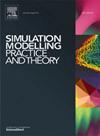3D vision object detection for autonomous driving in fog using LiDaR
IF 3.5
2区 计算机科学
Q2 COMPUTER SCIENCE, INTERDISCIPLINARY APPLICATIONS
引用次数: 0
Abstract
Connected and Autonomous Vehicles (CAVs) are transforming transportation. The paper describes a new method of fog simulation applied to LiDAR data for self-driving cars with a focus on enhancing 3D object detection in low visibility conditions. As opposed to the previously used methods, synthetic fog augmentation is combined with deep learning models and it is proven that the proposed method is superior to the previous methods when it comes to object detection accuracy in various fog levels. Another challenge that has been discussed in the study to ensure the reliability of autonomous navigation is the question of how the fog and the LiDAR point cloud should be modeled which eventually helps in improving the decision-making safety and operation. Fog can drastically reduce visibility and safety, making it crucial to test LiDAR-based perception algorithms for CAVs under such conditions. These simulations aim to ensure CAVs can navigate safely and efficiently through fog. However, challenges like sensor calibration and data integration need to be addressed. Despite these hurdles, the research foresees a future where CAVs, equipped with advanced LiDAR-based perception algorithms and fog-handling capabilities, enhance safety and efficiency in transportation. Notably, using synthetic fog augmentation improved detection by 5.27% for cars and 8.11% for cyclists. Furthermore, the study showcases improvements of 4.76%, 2.92%, and 3% in Mean Average Precision (mAP) across the distinct object categories of easy, moderate, and hard difficulty levels, respectively.
基于激光雷达的雾中自动驾驶3D视觉目标检测
联网和自动驾驶汽车(cav)正在改变交通方式。本文介绍了一种应用于自动驾驶汽车激光雷达数据的雾模拟新方法,重点是增强低能见度条件下的3D物体检测。与之前使用的方法相比,将合成雾增强与深度学习模型相结合,并证明了所提出的方法在不同雾度下的目标检测精度优于之前的方法。为了确保自主导航的可靠性,研究中讨论的另一个挑战是如何对雾和激光雷达点云进行建模,最终有助于提高决策安全性和操作。雾会大大降低能见度和安全性,因此在这种情况下测试基于激光雷达的自动驾驶汽车感知算法至关重要。这些模拟旨在确保自动驾驶汽车能够安全有效地在雾中行驶。然而,传感器校准和数据集成等挑战需要解决。尽管存在这些障碍,但该研究预测,未来配备先进的基于激光雷达的感知算法和雾处理能力的自动驾驶汽车将提高运输的安全性和效率。值得注意的是,使用合成雾增强技术,对汽车和自行车的检测分别提高了5.27%和8.11%。此外,该研究还显示,在简单、中等和困难难度的不同对象类别中,平均平均精度(mAP)分别提高了4.76%、2.92%和3%。
本文章由计算机程序翻译,如有差异,请以英文原文为准。
求助全文
约1分钟内获得全文
求助全文
来源期刊

Simulation Modelling Practice and Theory
工程技术-计算机:跨学科应用
CiteScore
9.80
自引率
4.80%
发文量
142
审稿时长
21 days
期刊介绍:
The journal Simulation Modelling Practice and Theory provides a forum for original, high-quality papers dealing with any aspect of systems simulation and modelling.
The journal aims at being a reference and a powerful tool to all those professionally active and/or interested in the methods and applications of simulation. Submitted papers will be peer reviewed and must significantly contribute to modelling and simulation in general or use modelling and simulation in application areas.
Paper submission is solicited on:
• theoretical aspects of modelling and simulation including formal modelling, model-checking, random number generators, sensitivity analysis, variance reduction techniques, experimental design, meta-modelling, methods and algorithms for validation and verification, selection and comparison procedures etc.;
• methodology and application of modelling and simulation in any area, including computer systems, networks, real-time and embedded systems, mobile and intelligent agents, manufacturing and transportation systems, management, engineering, biomedical engineering, economics, ecology and environment, education, transaction handling, etc.;
• simulation languages and environments including those, specific to distributed computing, grid computing, high performance computers or computer networks, etc.;
• distributed and real-time simulation, simulation interoperability;
• tools for high performance computing simulation, including dedicated architectures and parallel computing.
 求助内容:
求助内容: 应助结果提醒方式:
应助结果提醒方式:


